 Ilustración de las regiones de campo lejano, campo cercano radiante y campo cercano reactivo cuando se irradia desde una antena con un diámetro de 0,1 metros en frecuencias de 2,4 GHz (izquierda) y 100 GHz (derecha). Esta ilustración demuestra que en el régimen de ondas milimétricas, la TIP basada en EM procedente de una antena de tamaño mediano a menudo da como resultado que los receptores estén ubicados en el campo cercano radiante [181]
Ilustración de las regiones de campo lejano, campo cercano radiante y campo cercano reactivo cuando se irradia desde una antena con un diámetro de 0,1 metros en frecuencias de 2,4 GHz (izquierda) y 100 GHz (derecha). Esta ilustración demuestra que en el régimen de ondas milimétricas, la TIP basada en EM procedente de una antena de tamaño mediano a menudo da como resultado que los receptores estén ubicados en el campo cercano radiante [181]la técnica strip-line para la transferencia de energía inalámbrica. Son de interés dos tipos de estructuras de líneas de franjas. El primer tipo es una estructura asimétrica o de microcinta. Para este tipo de estructuras, el campo electromagnético se concentra exclusivamente entre la línea microstrip, por su cara interior, y el sustrato conductor. El segundo tipo incluye una estructura de línea de tira simétrica para la cual el campo electromagnético se concentra entre ambos lados de la línea de tira y ambos sustratos conductores. Ambas estructuras tienen pérdidas de energía electromagnética insignificantes y no irradian energía electromagnética en el espacio libre .[183]
Recientemente, se ha propuesto la superficie inteligente reconfigurable (RIS) como una nueva tecnología prometedora para reconfigurar el entorno de propagación inalámbrica a través de la reflexión de señales controlada por software. [183]
técnica de síntesis de matrices bastante general capaz de tener en cuenta, simultáneamente, los requisitos tanto del campo cercano como del campo lejano, La técnica propuesta se basa en la minimización directa de una función de costos diseñada para optimizar los pesos aplicados a un conjunto de antena [168]
reflectarrays de alimentación múltiple [169]

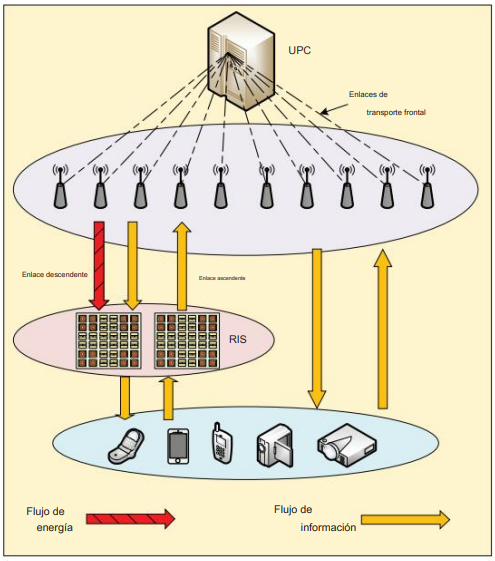
Estrategias
la radiación EM debe concentrarse en la dirección hacia el receptor de energía mediante el uso de una antena direccional o un conjunto de antenas para implementar la formación de haces de energía. [1]
PowerCast adoptan múltiples antenas y formación de haz en la tecnología Mid Field Wat-tup de Energous (12 metros, 3 W) [1]
Los RPEV reciben energia por bobinas debajo de su estructura cuando estan en movimiento. no dependen de baterías de alta capacidad. [1] [3]
 . Red de retransmisión D2D con dos nodos EH y un nodo de retransmisión. cada nodo EH tiene un SC y una batería. El SC debe almacenar la energía recolectada y la batería con almacenamiento de energía infinito se utiliza para proporcionar energía estable. [1]
. Red de retransmisión D2D con dos nodos EH y un nodo de retransmisión. cada nodo EH tiene un SC y una batería. El SC debe almacenar la energía recolectada y la batería con almacenamiento de energía infinito se utiliza para proporcionar energía estable. [1]MEC
 La red MEC inalámbrica. (a) modelo de red. b) protocolo para la descarga
de datos WPT de enlace descendente y ascendente[129]
La red MEC inalámbrica. (a) modelo de red. b) protocolo para la descarga
de datos WPT de enlace descendente y ascendente[129]En cada franja horaria hay dos fases diferenciadas: la fase TIP y la fase de descarga de datos. En la primera fracción de tiempo µ0(t) , el nodo de borde habilita todos los sensores inalámbricos a través de la transmisión de señales de energía. Luego, los sensores utilizan la energía recolectada para transmitir los datos recopilados al nodo de borde en una secuencia sin superposición [129]
abordar el problema doblemente cercano-lejano en WPCN
Microondas
Se examinó la frecuencia de 2,45 GHz para suministrar 10 kW de energía eléctrica a un pequeño pueblo aislado en la Isla Reunión, Francia [186]
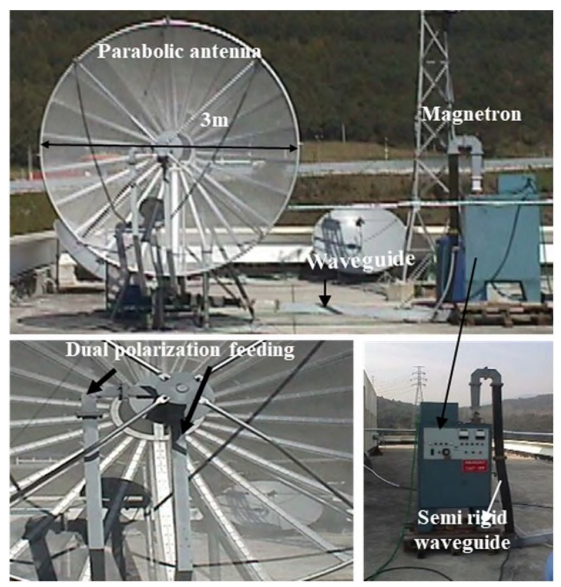 Fig. 2 Fotografías del sistema transmisor de alta potencia. Sistema Tx (superior), guía de ondas de alimentación de polarización dual y magnetrón. [187]
Fig. 2 Fotografías del sistema transmisor de alta potencia. Sistema Tx (superior), guía de ondas de alimentación de polarización dual y magnetrón. [187] . Circuito rectificador (superior) y fotografía del circuito rectificador fabricado utilizando FR 4 de 1,6 mm de espesor. [187]
. Circuito rectificador (superior) y fotografía del circuito rectificador fabricado utilizando FR 4 de 1,6 mm de espesor. [187]La antena, la antena dipolo DP y la antena Yagi SP se muestran en la Fig. 3. Para probar la eficiencia de conversión RF-DC, se utilizan una fuente de RF de 5 W y una antena de bocina de 10 dBi. La distancia entre las antenas Tx y Rx es de 1 m y la potencia de recepción es de 8 dBm [187]
 Se muestra que el caso de la antena de parche DP tendrá una mejor eficiencia de conversión RF-DC en todos los ángulos, mientras que la antena Yagi SP tiene la mejor eficiencia de conversión RF-DC cerca del ángulo incidente de 90°. La razón es que la antena Yagi tendrá la mayor ganancia de las antenas. A partir de la prueba, se selecciona una antena de parche DP para la matriz de rectenas. [187]
Se muestra que el caso de la antena de parche DP tendrá una mejor eficiencia de conversión RF-DC en todos los ángulos, mientras que la antena Yagi SP tiene la mejor eficiencia de conversión RF-DC cerca del ángulo incidente de 90°. La razón es que la antena Yagi tendrá la mayor ganancia de las antenas. A partir de la prueba, se selecciona una antena de parche DP para la matriz de rectenas. [187]
Frecuencias
la estación portátil de transmisión de energía de microondas con una frecuencia de operación de fr = 2.45GHz y una potencia de microondas de 100 Watts.
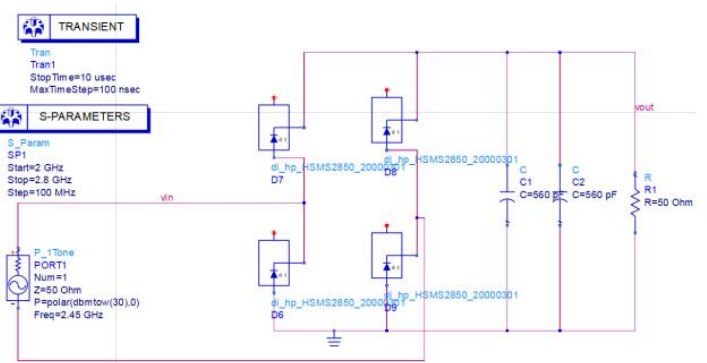
Energía y Datos
Un circuito rectificador siempre está compuesto por un filtro de entrada, una red de adaptación de impedancia, un diodo y un filtro de salida. [112]
El filtro de entrada se utiliza para suprimir los armónicos producidos por el diodo. [112]
El filtro de salida se utiliza para obstruir la fundamental y los armónicos. [112]
Para recolectar eficazmente energía de microondas, se han propuesto metasuperficies electromagnéticas [112]
las microondas se utiliza aquí como en la aplicación del absorbente, aunque con una pequeña diferencia en que aquí la energía de microondas no se convertirá en calor sino en energía de CC a través del circuito rectificador. [112]
La unidad de superficie rectificadora se diseñará cuidadosamente para absorber más potencia de RF y manejar la conversión con alta eficiencia [112]125
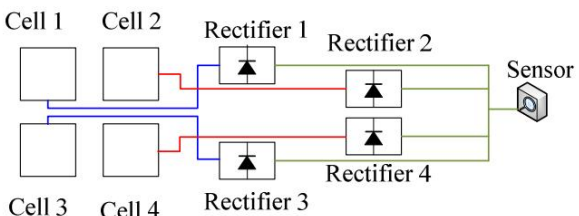


 Procedimiento de trabajo para la gestión de recursos entre el conocimiento de datos y las capas de borde. [129]
Procedimiento de trabajo para la gestión de recursos entre el conocimiento de datos y las capas de borde. [129]
Paso 1 (Intercambio de información): el nodo de borde transmite la información de su acumulación de datos a todos los sensores bajo su cobertura. Los sensores que tienen una gran acumulación de datos envían sus pilotos al nodo de borde para realizar mediciones del canal y brindan información sobre el estado de su dispositivo para la asignación de recursos. por turnos. En el lado del nodo de borde, los datos llegados primero se pondrán en cola en el DSM del nodo y luego se transferirán al ECM para su procesamiento. Como solo una pequeña parte de los dispositivos que tienen una larga acumulación de datos necesitan enviar retroalimentación, se podrían evitar muchos gastos generales del sistema [129]
Paso 2 (Actualización de datos): sobre la base de la decisión de optimización tomada por DMCM, DSM en cada sensor individual recopila o elimina datos de acuerdo con los resultados de optimización ai(t) y di(t). La complejidad computacional de la optimización es O(1), que es adecuada para sensores con recursos limitados [129]
Paso 3 (Transferencia de energía inalámbrica): El DMCM en el nodo de borde determina las porciones de tiempo óptimas en función del estado del nodo de borde y la información desactualizada intercambiada en el Paso 1. Posteriormente, el ETM del nodo de borde toma µ0(t) fracción de tiempo de la ranura para recargar los EHSM de los sensores emitiendo una señal de banda base.[129]
Paso 4 (Descarga de datos): Con la energía recolectada, Los DSM en los sensores utilizan sus porciones de tiempo asignadas para descargar por turnos. En el lado del nodo de borde, los datos llegados primero se pondrán en cola en el DSM del nodo y luego se transferirán al ECM para su procesamiento. [129]
1 Diagrama esquemático del sistema MCR-TIP. La línea roja indica la ruta del flujo de energía y la línea azul indica la ruta de transmisión de da [130]
a) Con enlace de datos independiente. [130]
b) El concepto original de la tecnología WPIDT. [130]
c) Un esquema WPIDT práctico mediante la multiplexación de reguladores CC-CC en cascada para transmisor de datos.[130]
La modulación de cambio de carga (LSK) es un
método común para la transmisión ascendente en dispositivos IPT que cumplen
con el estándar Qi13[130]
Electronica de potencia
Ecuaciones KVL para el sistema WPIDT.
sistema inalámbrico de transferencia dual de energía e información
 Formas de flujo de potencia en el sistema MCR-WPT. Diagrama de circuito del sistema MCR-WPT. S1 ~ S4 denotan los interruptores del inversor y D1 ~ D4 denotan los diodos del rectificador. E1 es la fuente de CC de entrada, Cd2 es la capacitancia del filtro y RL es la resistencia de carga. [142]
Formas de flujo de potencia en el sistema MCR-WPT. Diagrama de circuito del sistema MCR-WPT. S1 ~ S4 denotan los interruptores del inversor y D1 ~ D4 denotan los diodos del rectificador. E1 es la fuente de CC de entrada, Cd2 es la capacitancia del filtro y RL es la resistencia de carga. [142] E1, v2 son los voltajes de entrada y salida del inversor, g(t) es una función de onda cuadrada unitaria [130] [142]
E1, v2 son los voltajes de entrada y salida del inversor, g(t) es una función de onda cuadrada unitaria [130] [142] Formas de onda y espectro de flujo de energía e información en el sistema WPIDT vía MCR. a Diagrama de bloques del sistema WPIDT. v1p denota el voltaje de CC y
v1m denota el voltaje de información, v4m denota el voltaje de información recuperado.
Formas de onda y espectro de flujo de energía e información en el sistema WPIDT vía MCR. a Diagrama de bloques del sistema WPIDT. v1p denota el voltaje de CC y
v1m denota el voltaje de información, v4m denota el voltaje de información recuperado.  Como mezclador, el inversor multiplica el voltaje de entrada por una onda
cuadrada diseñada con frecuencia f en su salida [130]La red MCR pasiva, que consta de bobinas y
componentes de compensación, es un canal de paso de banda adecuado para
transmitir [130]
Como mezclador, el inversor multiplica el voltaje de entrada por una onda
cuadrada diseñada con frecuencia f en su salida [130]La red MCR pasiva, que consta de bobinas y
componentes de compensación, es un canal de paso de banda adecuado para
transmitir [130]es el caso de la comunicación ascendente ya que la informaciónse transmite en la dirección opuesta a la transferencia de energia[130]
 Diagrama de bloques de la ruta de transmisión ascendente WPIDT basada en MCR, los datos de banda base se modulan PSK y se integran en la potencia de CC (Tx CH1) a través del circuito reductor, se mezclan en frecuencia mediante el rectificador y se convierten ascendentemente a la banda lateral de 6,78 MHz (Vo CH3), se transmiten al lado frontal a través del canal MCR (Vi CH4), se mezclan en frecuencia mediante el inversor y se convierten descendentemente a la señal modulada PSK (Rx CH3) y, finalmente, se restauran a los datos de banda base originales a través del circuito de filtrado y algoritmos de demodulación (Rx CH4).[130]
Diagrama de bloques de la ruta de transmisión ascendente WPIDT basada en MCR, los datos de banda base se modulan PSK y se integran en la potencia de CC (Tx CH1) a través del circuito reductor, se mezclan en frecuencia mediante el rectificador y se convierten ascendentemente a la banda lateral de 6,78 MHz (Vo CH3), se transmiten al lado frontal a través del canal MCR (Vi CH4), se mezclan en frecuencia mediante el inversor y se convierten descendentemente a la señal modulada PSK (Rx CH3) y, finalmente, se restauran a los datos de banda base originales a través del circuito de filtrado y algoritmos de demodulación (Rx CH4).[130]El método PSDM se emplea en el convertidor reductor, con la frecuencia de conmutación establecida en 800 kHz y la frecuencia del portador de datos establecida en 100 kHz. Los datos se modulan con 8DPSK y se transmiten mediante el convertidor reductor con η= 0:01[130]
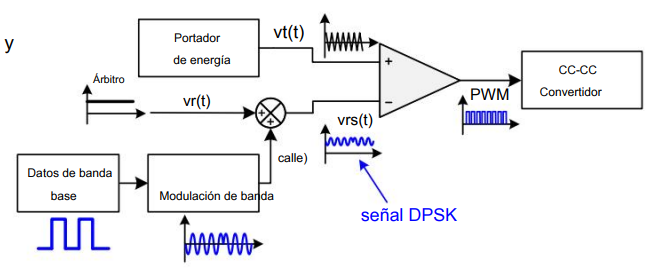 Procesos de modulación de datos en el convertidor mediante el método PSDM.
La línea azul denota la señal. Vt(t) es la portadora triangular, Vr(t) es la salida del
bucle de control de potencia, s(t) es la señal de datos y Vrs(t) es la señal integrada
de potencia y datos.[130]
Procesos de modulación de datos en el convertidor mediante el método PSDM.
La línea azul denota la señal. Vt(t) es la portadora triangular, Vr(t) es la salida del
bucle de control de potencia, s(t) es la señal de datos y Vrs(t) es la señal integrada
de potencia y datos.[130]modulación dual de potencia y señal con portadora única (PSDM-SC), emplea la portadora de energía como portadora de datos. [130]
Modulación dual de potencia y señal en lazo de control (PSDM-CL) superpone una señal de baja frecuencia en el bucle de control de potencia como portador de datos En el sistema prototipo, se utiliza el método PSDM-CL tanto en el convertidor elevador del lado frontal como en el convertidor reductor del lado de carga, y se abrevia como PSDM en el artículo. En este proceso se pueden emplear métodos de modulación convencionales, como modulación por desplazamiento de amplitud (ASK), modulación por desplazamiento de frecuencia (FSK), modulación por desplazamiento de fase (PSK) y modulación multiportadora. En este experimento, se emplea el esquema de modulación 8DPSK para aumentar la tasa de bits.[130]
la portadora de datos se puede representar por una secuencia de ciclo de trabajo..[130]
Para sincronizar el transmisor y el receptor se utiliza un preámbulo de cinco símbolos de sincronización Sobre la base del momento del desplazamiento de fase, se determinan la fase inicial de la señal recibida y el comienzo de una trama y posteriormente se emplean para la demodulación. El procedimiento correspondiente se ilustra en Fi Implementación del método de sincronización y emodulación. a Estructura de trama.
Sobre la base del momento del desplazamiento de fase, se determinan la fase inicial de la señal recibida y el comienzo de una trama y posteriormente se emplean para la demodulación. El procedimiento correspondiente se ilustra en Fi Implementación del método de sincronización y emodulación. a Estructura de trama.Sobre la base del momento del desplazamiento de fase, se determinan la fase inicial de la señal recibida y el comienzo de una trama y posteriormente se emplean para la demodulación. El procedimiento correspondiente se ilustra en Fi
Implementación del método de sincronización y emodulación. a Estructura de trama.
, para maximizar el PTE y utilizar el área mínima de la superficie de transmisión, es necesario utilizar la región con alto flujo de corriente. Para maximizar la integral del numerador en un área de transmisión limitada, se debe eliminar cualquier corriente base por debajo de cierto valor porque contribuye menos a la potencia de recepción de la antena móvil. Utilizando este enfoque, se pueden relacionar el PTE máximo y el área de transmisión mínima [161]
 . Diagrama de flujo de las relaciones entre el área de transmisión, la distancia
de transferencia y el PTE [161]
. Diagrama de flujo de las relaciones entre el área de transmisión, la distancia
de transferencia y el PTE [161]El PTE máximo límite para la antena dipolo, indicado como una línea negra, es relativamente bajo (44,2%) , ene un patrón de radiación omnidireccional, el PTE máximo no puede exceder el 50% cuando se utiliza solo una superficie de transmisión plana. Sin embargo, si la superficie BS se implementara en ambos lados del dipolo o como una forma conforme, se incrementaría el límite de eficiencia máxima[161]
el resultado PTE de la antena de parche mejora mucho. frecuencia de funcionamiento cuando todas las longitudes eléctricas del sistema son fijas. Esto se debe a que la magnitud de la corriente de base óptima en la superficie tangencial dada está determinada únicamente por el patrón del campo radiante de la antena móvil, como se describe en (8). También puede explicarse mediante (11) con la configuración de la Fig. 1 (b). La ecuación (11) implica que la PTE máxima es la relación entre la potencia radiada a todo el espacio y la potencia que pasa a través de la superficie BS dada. Esto se debe a que el parche emite la mayor parte de su campo hacia un solo lado, lo que enfoca mejor el campo radiante en la superficie de la BS. Para la antena de parche, se puede lograr un PTE del 20% utilizando un área de transmisión de 11λ2 (0,17 m2). Si la antena de parche está diseñada para enfocar una mayor parte del campo en la superficie de la EB, el PTE puede aumentarse aún más, aunque el área de la superficie de transmisión sería la misma. [161]
Una antena de bocina, que es un tipo de antena de apertura, ofrece el mejor
rendimiento. El límite de PTE de la antena de bocina converge a casi el 97,4% para
un tamaño grande de apertura de transmisión. Cuando se utiliza la antena de bocina,
un área de transmisión de sólo 4λ2 (0,06 m2) puede alcanzar el PTE objetivo. [161]
Los errores relativos máximos son 2,8%, 1,4% y 0,5% para la antena dipolo, parche y
bocina, respectivamente. Estas diferencias ocurren porque los dipolos infinitesimales
discretos no pueden realizar una corriente de base óptima exacta, que es continua. El
PTE máximo teórico y simulado [161]
MPT utilizando una antena móvil compacta, como una antena de parche, puede lograr una PTE alta cuando la distancia de transferencia está dentro de la región de Fresnel. [161]
cuando hay un receptor de ID y varios receptores de EH, el diseño óptimo es asignar una parte de la potencia al receptor de ID para satisfacer la restricción de tasa suma, mientras que la potencia restante se asigna a un receptor de EH. con la máxima prioridad EH [179]
algoritmo eficiente para obtener una solución subóptima utilizando los métodos de eliminación de variables binarias y SCA. Se presentan resultados numéricos para corroborar la eficacia del esquema propuesto frente a varios esquemas de referencia.[179]
Con el aumento significativo de la frecuencia portadora y del número de antenas, la conocida distancia de Rayleigh se ampliará hasta decenas o incluso cientos de metros. [179]
n método eficiente de entrenamiento con haz de dos fases que primero estima el ángulo espacial y luego determina la distancia del usuario. Este método se basa en un hecho clave de que el verdadero ángulo espacial del usuario se encuentra aproximadamente en el medio de una región angular dominante con potencias de señal recibidas suficientemente altas cuando se utilizan haces DFT de campo lejano para el entrenamiento de haces. Los gastos generales de formación necesarios pueden aumentar aún más. [180]
se reduce diseñando un entrenamiento jerárquico de haces de campo cercano [179] y explotando métodos de aprendizaje profundo para el entrenamiento de haces [179].
considere una estación base (BS) que tiene una antena de 0,5 metros (m) de diámetro y opera a una frecuencia de 30 GHz. La conocida distancia de Rayleigh en este escenario es de unos 50 m. Esto significa que en un escenario de comunicación típico, los usuarios pueden estar ubicados en las regiones de campo cercano y lejano de la BS, lo que genera problemas de diseño más complicados, como la estimación de canales de campo mixto/híbrido[179].
coexistencia y gestión de interferencias de usuarios de campo mixto [179].
e debido al efecto
de dispersión de energía, el usuario de campo cercano puede sufren una fuerte
interferencia del haz de campo lejano basado en DFT, cuando su ángulo espacial
está en la vecindad del ángulo del usuario de campo lejano. Por otro lado, dicha
fuga de energía del haz de campo lejano basado en DFT también se puede utilizar
para cargar eficientemente al usuario de campo cercano, lo que lleva a la nueva
aplicación de transferencia inalámbrica simultánea de información y energía (SWIPT)
de campo mixto, donde en Los receptores de recolección de energía (EH) y
decodificación de información (ID) están ubicados en el campo cercano y lejano,
respectivamente. [179].
el UAV puede recibir energía de fuentes de energía ambientales, así como de BS para reponer el almacenamiento de energía. Además, como método para recopilar datos, el UAV también puede activar o compensar dispositivos IoT en el entorno para alentar a los dispositivos a detectar y transferir datos al UAV [179]
un sistema de recopilación y entrega de datos asistido por UAV en sistemas IoT, donde el UAV está equipado con funcionalidades de transferencia de energía inalámbrica para cargar dispositivos IoT para recopilar datos, así como recibir energía de estaciones base para cargar la batería del UAV [179]
Laser
El algoritmo propuesto para encontrar el ciclo de trabajo óptimo del láser (LD) se basa en dos modos principales: Modo 1 y Modo 2.
Modo 1: Búsqueda Inicial
- Perturbación y Observación: Este modo utiliza el concepto de perturbación y observación. En cada paso, se disminuye el ciclo de trabajo mientras se incrementa la amplitud máxima de la corriente de entrada del LD para asegurar una potencia de salida constante del PV.
- Almacenamiento de Parámetros: Durante este proceso, se almacenan el ciclo de trabajo correspondiente , la amplitud máxima de la corriente de entrada , la eficiencia del sistema , la potencia de carga de la batería y el rizo de voltaje de salida del PV .
- Parada de Búsqueda: El proceso de disminución del ciclo de trabajo continúa hasta que no sea posible un incremento adicional en la eficiencia del sistema debido al efecto del rizo de voltaje, alcanzando un punto de máxima eficiencia local. Si disminuye hasta su valor mínimo , el proceso de búsqueda se detiene.
Modo 2: Optimización de la Eficiencia
- Continua Reducción del Ciclo de Trabajo: Después de alcanzar el punto de máxima eficiencia local en el Modo 1, el ciclo de trabajo continúa disminuyendo mientras la potencia óptica se perturba correspondientemente para mejorar aún más la eficiencia del sistema.
- Comparación y Actualización de Parámetros: Se calcula la nueva eficiencia del sistema y la disminución de la potencia de carga de la batería . Estos valores se comparan con la eficiencia del sistema almacenada y un coeficiente límite , que equilibra la eficiencia del sistema y la potencia de carga. Si es mayor que y es menor que , se actualizan los valores óptimos almacenados.
- Continuación del Proceso: El proceso continúa en el Modo 2 hasta que .
[15] Uiliza un láser de alta potencia de 980 nm como fuente de luz para la transmisión de energía.
Rendimiento de la celda
La transferencia de energía inalámbrica bidireccional (BWPT)
 Arquitectura del sistema BD-IPT propuesta para la carga de vehículos eléctricos. BD-IPT, transferencia de potencia inductiva bidireccional; EV, vehículos eléctricos [161]
Arquitectura del sistema BD-IPT propuesta para la carga de vehículos eléctricos. BD-IPT, transferencia de potencia inductiva bidireccional; EV, vehículos eléctricos [161]WPIDR duplex
 Circuito simplificado del sistema WPIDT basado en MCR. E1 es la fuente de CC de entrada, Cd1 y Cd2 son la capacitancia del filtro y RL es la resistencia de carga. Vs1 y Vs2 indican la fuente de datos, Vs0 y Vl0 indican el voltaje del receptor de datos. Zs0 y Zl0 indican los circuitos de adaptación, Rs1 y Rl2 son la resistencia, Cs1 y Cl2 son la capacitancia, Ls1 y Ll2 son la inductancia.
Circuito simplificado del sistema WPIDT basado en MCR. E1 es la fuente de CC de entrada, Cd1 y Cd2 son la capacitancia del filtro y RL es la resistencia de carga. Vs1 y Vs2 indican la fuente de datos, Vs0 y Vl0 indican el voltaje del receptor de datos. Zs0 y Zl0 indican los circuitos de adaptación, Rs1 y Rl2 son la resistencia, Cs1 y Cl2 son la capacitancia, Ls1 y Ll2 son la inductancia. Modelo de circuito del sistema WPIDT: b1 corresponde a un modelo lineal simplificado de dos puertos, ViM y VoM denotan la fuente de datos equivalente, Zs y Zl denotan la impedancia equivalente, v1 y v2 denotan el voltaje de salida de la señal. b2 corresponde a un modelo equivalente de sistema basado en MCR. C1 ~ C4 denotan la capacitancia, Rp1 ~ Rp4 denotan la resistencia y L1 ~ L4 denotan la inductancia de los resonadores. k12, k23 y k34 denotan el coeficiente de acoplamiento de las bobinas, ds es la distancia entre L2 y L3
Modelo de circuito del sistema WPIDT: b1 corresponde a un modelo lineal simplificado de dos puertos, ViM y VoM denotan la fuente de datos equivalente, Zs y Zl denotan la impedancia equivalente, v1 y v2 denotan el voltaje de salida de la señal. b2 corresponde a un modelo equivalente de sistema basado en MCR. C1 ~ C4 denotan la capacitancia, Rp1 ~ Rp4 denotan la resistencia y L1 ~ L4 denotan la inductancia de los resonadores. k12, k23 y k34 denotan el coeficiente de acoplamiento de las bobinas, ds es la distancia entre L2 y L3 Fotografía del sistema prototipo correspondiente a a. c Fotografía de la placa de circuito del lado frontal. d Fotografía de la placa de circuito del lado de carga. e Comparación entre los valores teóricos y medidos de jS21j cuando ds = 70 cm. fs es la frecuencia de barrido y Ws es el ancho de banda. f Comparación de los valores teóricos y medidos de jS12j cuando ds = 70 cm
Fotografía del sistema prototipo correspondiente a a. c Fotografía de la placa de circuito del lado frontal. d Fotografía de la placa de circuito del lado de carga. e Comparación entre los valores teóricos y medidos de jS21j cuando ds = 70 cm. fs es la frecuencia de barrido y Ws es el ancho de banda. f Comparación de los valores teóricos y medidos de jS12j cuando ds = 70 cmEn el prototipo del sistema WPIDT, el convertidor elevador frontal funciona como regulador de potencia y transmisor de datos para la comunicación descendente. Como regulador de potencia, regula el voltaje de CC de salida en función de la retroalimentación del lado de la carga; como transmisor de datos, transmite señales de datos moduladas a una frecuencia f 1.
Para Superficies metalica
Sistema inalámbrico basado en ondas Zenneck (ZW)
 . El sistema de transmisión Zenneck Wave, (a) modos de campo localizados excitados en las superficies metálicas (b) a través de
escudos parciales de Faraday, supera a los sistemas TIP basados en acoplamiento (c) transferencia de energía a través de obstáculos metálicos.[140]
. El sistema de transmisión Zenneck Wave, (a) modos de campo localizados excitados en las superficies metálicas (b) a través de
escudos parciales de Faraday, supera a los sistemas TIP basados en acoplamiento (c) transferencia de energía a través de obstáculos metálicos.[140]Este sistema genera ondas electromagnéticas en la zona de frecuencia de RF en la interfaz del metal y el aire. Uno de los potenciales demostrados por el concepto era abordar el desafío de la transmisión de potencia de RF a través de escudos de Faraday parciales o con fugas [140]
transferencia simultánea de energía e información de ondas de luz (SLIPT)
El Panel Solar
Conmutación por tiempo

División del poder

División espacial

Trabajos
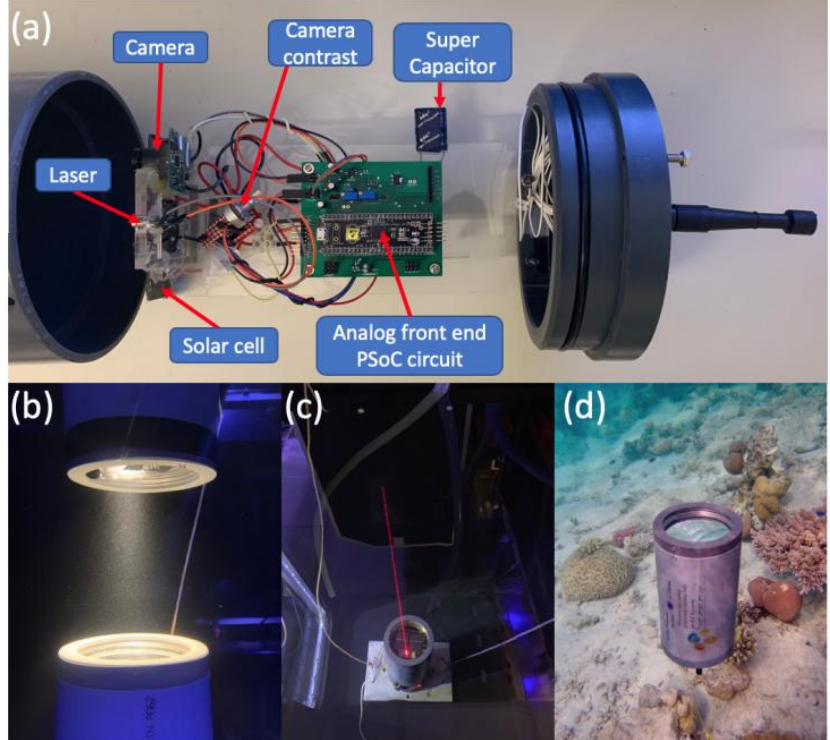 (a) Cámara submarina autoalimentada. Fotografía del módulo (b) siendo cargado por una fuente LED, (c) transmitiendo información (transmisión de video) con un láser rojo y (d) desplegado en un arrecife de coral en el Mar Rojo. [150]
(a) Cámara submarina autoalimentada. Fotografía del módulo (b) siendo cargado por una fuente LED, (c) transmitiendo información (transmisión de video) con un láser rojo y (d) desplegado en un arrecife de coral en el Mar Rojo. [150] Diseños de hardware para la transmisión de información y energía en un RIS. Tipo 1: Los elementos de captación de energía y de reflexión de información están completamente separados y distribuidos en bloques. Tipo 2: Estructura en bloques con separación incompleta de los elementos de captación de energía y de reflexión de información. Tipo 3: Los elementos de captación de energía y de reflexión de información se alternan entre sí en una distribución dispersa [183]
Diseños de hardware para la transmisión de información y energía en un RIS. Tipo 1: Los elementos de captación de energía y de reflexión de información están completamente separados y distribuidos en bloques. Tipo 2: Estructura en bloques con separación incompleta de los elementos de captación de energía y de reflexión de información. Tipo 3: Los elementos de captación de energía y de reflexión de información se alternan entre sí en una distribución dispersa [183]la comunicación inalámbrica óptica submarina (UWOC)
Bibliografia
[55] Charging. IEEE J. Emerg. Sel. Top. Power Electron. 2016, 4, 1015–1025 http://dx.doi.org/10.1049/iet-pel.2016.0655
[56] Lu, K.; Nguang, S.K.; Ji, S.; Wei, L. Design of auto frequency tuning capacitive power transfer system based on class-E2 dc/dc converter. IET Power Electron. 2017, 10, 1588–1595 http://dx.doi.org/10.1049/iet-pel.2016.0655
[57] Choi, J.; Tsukiyama, D.; Tsuruda, Y.; Davila, J.M.R. High-Frequency, High-Power Resonant Inverter With eGaN FET for Wireless Power Transfer. IEEE Trans. Power Electron. 2018. 33, 1890–189 https://ieeexplore.ieee.org/document/8010879/
[58] Lu, F.; Zhang, H.; Hofmann, H.; Mi, C. A Double-Sided LCLC-Compensated Capacitive Power Transfer System for Electric Vehicle Charging. IEEE Trans. Power Electron. 2015, 30, 6011–6014 https://ieeexplore.ieee.org/document/7127049
[59] .Qian, Z.; Yan, R.; Wu, J.; He, X. Full-Duplex High-Speed Simultaneous Communication Technology for Wireless EV Charging. IEEE Trans. Power Electron. 2019, 34, 9369–9373








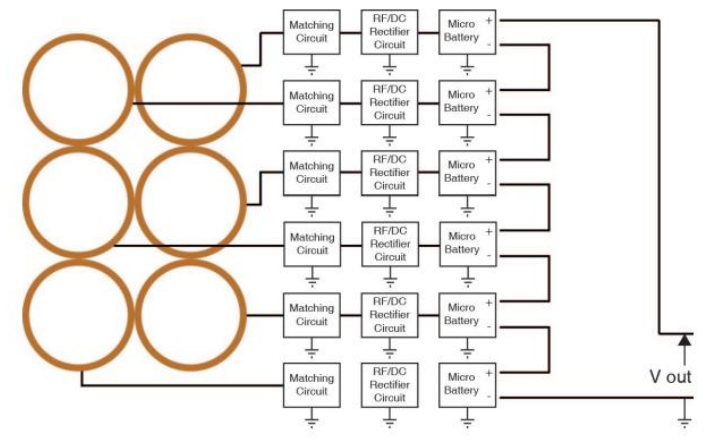









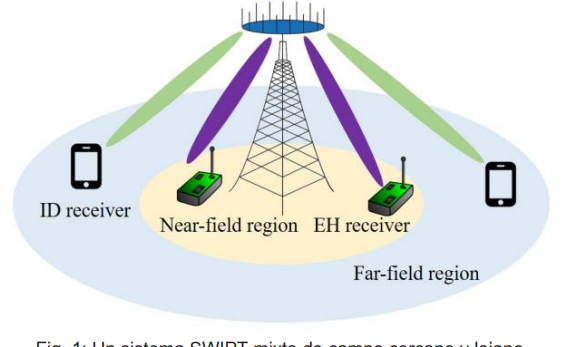

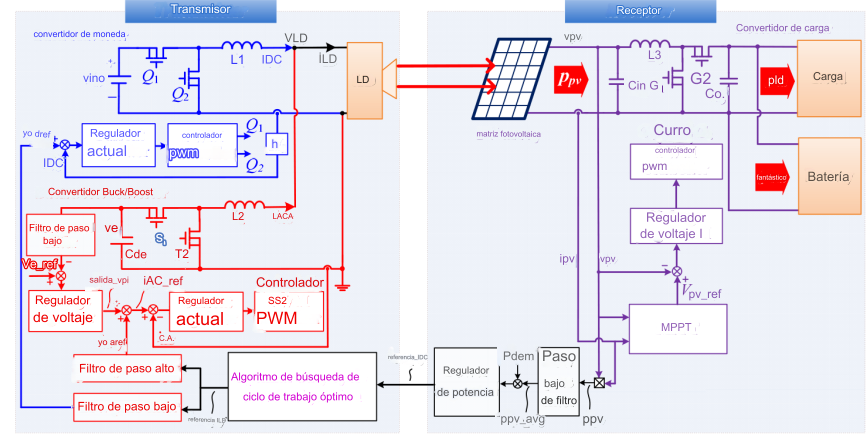

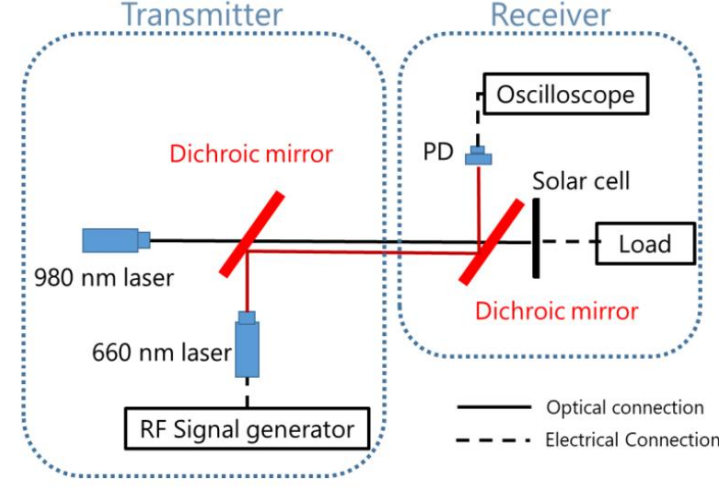

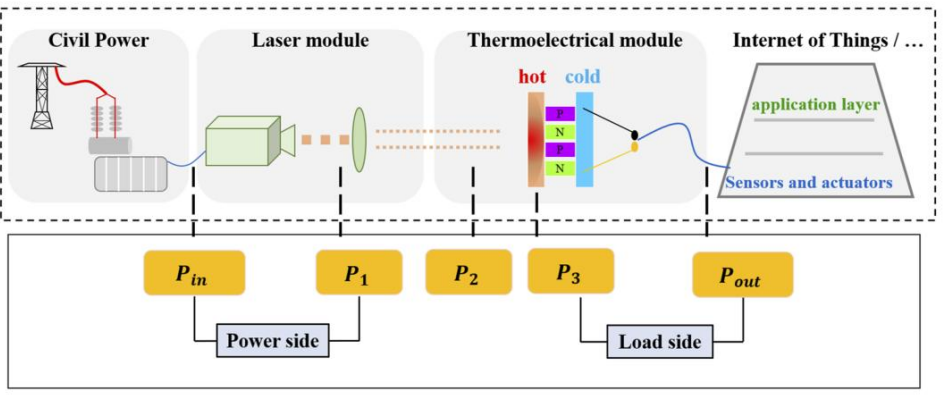

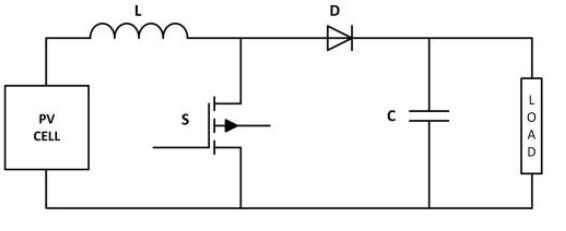


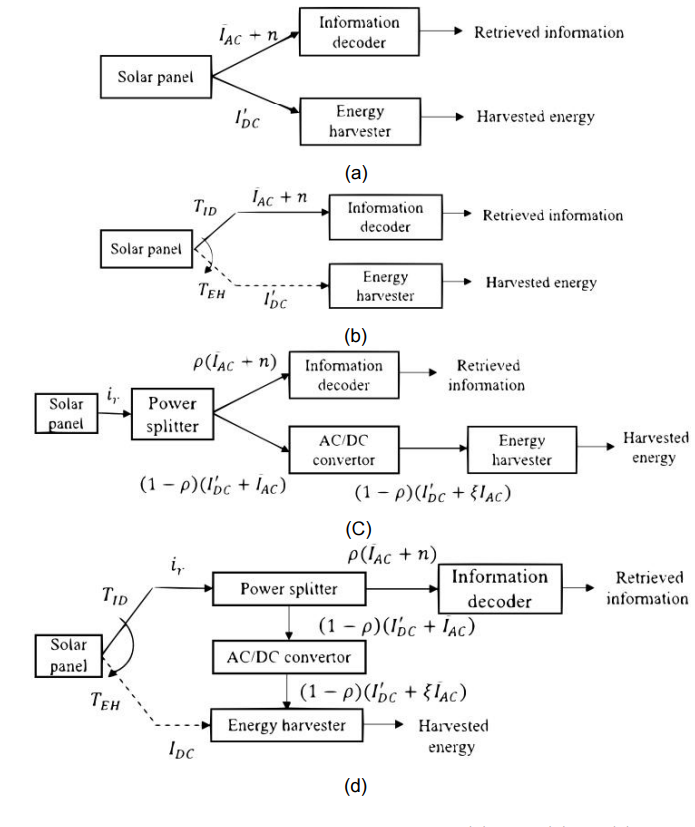

No hay comentarios.:
Publicar un comentario